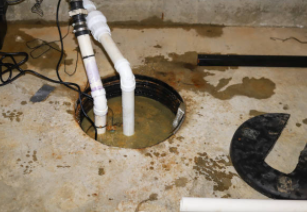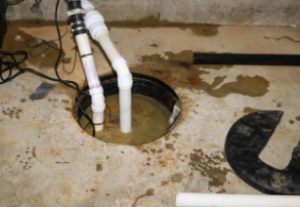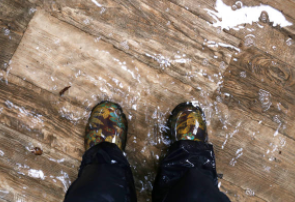All four seasons demand a functional sump pump. Spring, summer, and autumn rains force the sump pump into action. The thaws of snow and ice in winter, too, require that a sump pump be in optimal working condition. In short, a homeowner needs a functional sump pump even in winter.
What does a sump pump do?
A sump pump is designed to move rain and floodwater from the basement and out of the home. Featuring a naturally constructed pit (a hole beneath the surface of the basement floor), the sump pump operates with valves that sense rising water levels or pressure.
As water levels escalate, the sump pump eliminates the water through a discharge line, which leads out of the basement. The discharge line, also called an effluent, links the sump pump to a drainage area. Essentially, the sump pump protects the home from heavy rains and rising water levels.
A designated drainage area may be a pond, dry well, or neighborhood drain. The drain point should ideally be positioned far away from the home’s foundation, such as 10 to 20 feet, to prevent the water from returning to the home. Building codes determine where the pump can drain.
Why is a sump pump needed in winter?
Midwestern temperatures can plummet to below freezing in winter. On average, the December highs in Illinois’ northern towns reach 35 degrees Fahrenheit, and lows dip to 19 degrees Fahrenheit. January is even colder, with highs of 30 degrees and lows of 13 degrees Fahrenheit.
Freeze-thaw cycles can occur. A freeze-thaw cycle occurs when winter temperatures fluctuate from above the freezing point (32 degrees Fahrenheit) to below the freezing point and back up again. The thaw will cause the winter snow to melt, necessitating a functional sump pump.
Although the sump pump is not needed as often during the winter months, the pump is critical when the snow or ice melts. A sump pump may kick in to eliminate excess water at the height of winter. Homeowners should, as a result, ensure that the pump works without failing.
How do homeowners prep a sump pump for winter?
If the sump pump’s discharge pipe passes through an area that is unprotected from the cold, the water inside the line will freeze and lead to a blockage that prevents water from flowing through. The pump must work harder to push water through, and could fail.
A first line of defense against frozen discharge pipes is to bury them at least two feet below the area’s frost line. Alternately, insulation can prevent the discharge pipes from freezing in the subfreezing temps of winter; hay or tarp serve as adequate forms of insulation.
Remove the pump’s discharge hose for the winter, since frozen water inside the hose will render it unusable, at least until it thaws. The discharge hose connects the sump pump to the discharge pipe. Keep the discharge hose off until warmer weather returns.
Having a second discharge hose is recommended. A spare discharge hose is handy, since it can be inserted in the event that the primary one freezes or breaks. If the primary discharge hose freezes, remove it, attach the spare, and let the original one thaw out.
A basement has little insulation, making it one of the coldest parts of the home. Heat the home to prevent the pipes, including the discharge pipe, from freezing. Avoid setting the thermostat to lower than 55 degrees, since that is the lowest temperature to prevent frozen pipes.
Water inside the sump pump basin can turn into ice. Homeowners who run a steady trickle of water will prevent ice from forming. Flowing water rarely freezes; so, if possible, turn on a cold water tap and let it drip throughout the winter to avoid the risk of frozen pipes.
Keep the sump pump plugged in throughout the winter. Winter weather conditions can change in an instant—an unexpected warm front can pass through the vicinity. Homeowners who forget to plug the sump pump back in can end up with a wet basement when the snow melts.
Clean out the sump pump pit. Dirt, ice, and other debris can clog the intake or discharge pipe; the result of a blocked pipe will be a messy case of water damage. Homeowners who call in a professional to clean out the sump pump’s pit will prevent a disastrous flood.
It is important that homeowners test the sump pump on a routine basis. Frequent testing ensures that the pump will run at the opportune times—namely, during the unanticipated winter thaws. Simply run water through the sump pump in the winter months to ensure it is still functional.
Homes without a working sump pump during the winter are at risk for flooding and water damage. If your residential or business property undergoes water damage, call a water damage cleanup professional. Their crews will arrive quickly, stop the spread of damage, and return your property to its pre-loss condition.
Water damage can be the outcome of diverse events, from malfunctioning sump pumps, leaky appliances, or burst water pipes. A leaky roof and severe weather events can also cause significant water damage. Trained technicians will repair water damage caused by any source.
Comprehensive water damage restoration services start with an onsite assessment of the damage. Using advanced equipment, specialists extract the excess water and set up powerful dehumidifiers to thoroughly dry out the property. Repairs of damaged drywall and flooring are also available.



